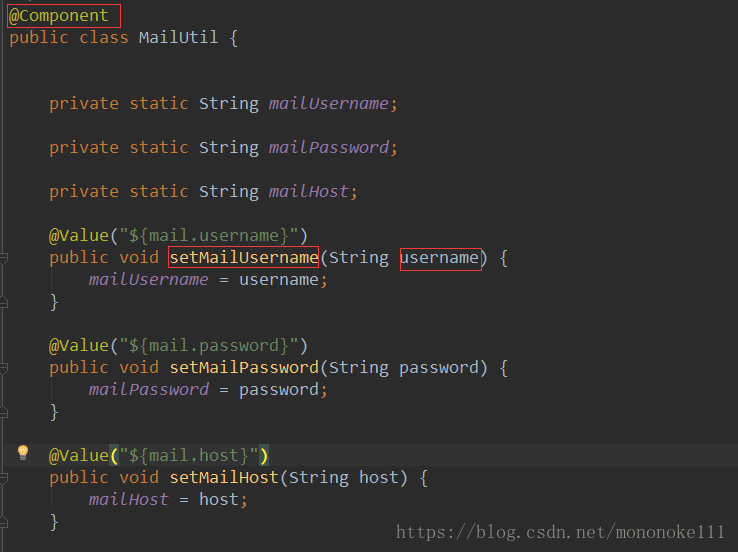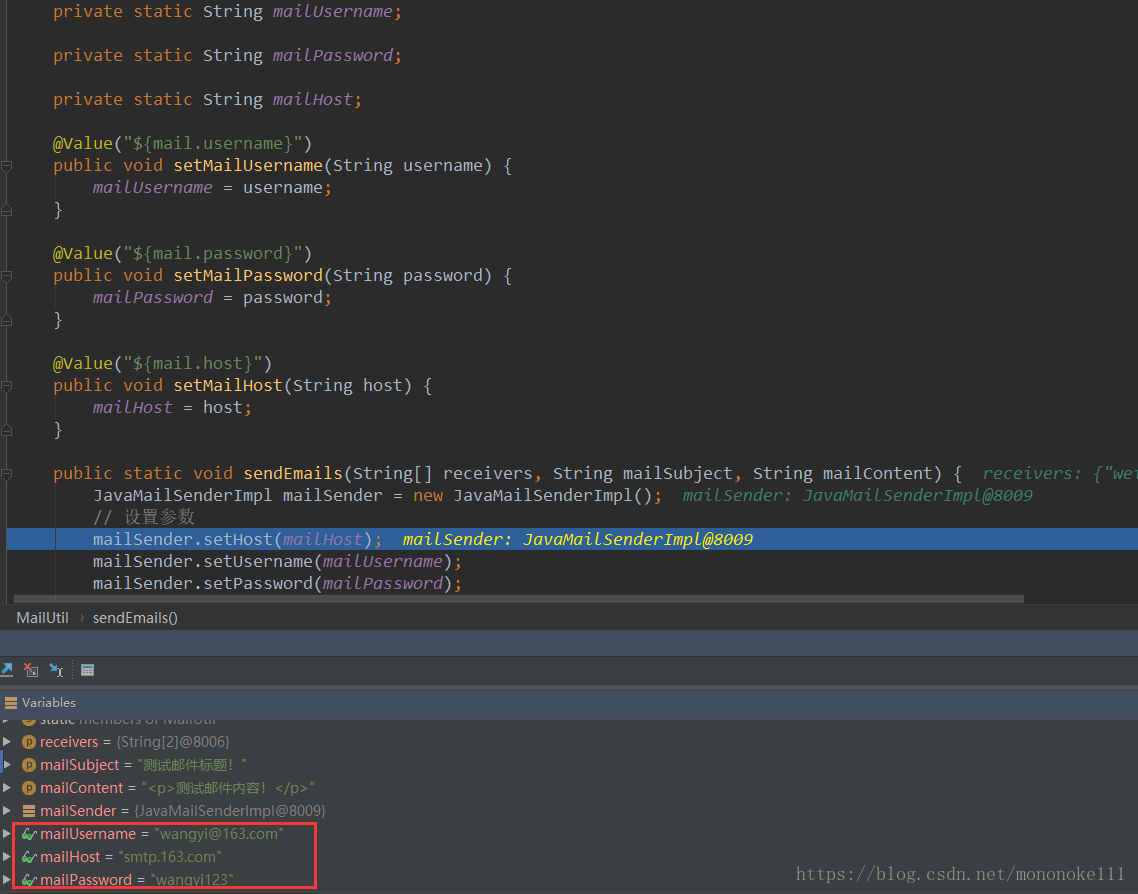Spring @Value 注解 使用总结一
@Value注入
不通过配置文件的注入属性的情况
通过@Value将外部的值动态注入到Bean中,使用的情况有:
1、注入普通字符串 如下例
直接附在属性名上,在 Bean 初始化时,会赋初始值
@Value("normal")
private String normal;
2、注入java 系统变量
@Value("#{systemProperties['os.name']}")
private String systemPropertiesName; // 注入操作系统属性
这里的 systemProperties 是 java的 System.getProperties() 方法获取的 java环境变量 ,查看java系统变量的方法如下
public String getproperties() { //获取所有的属性 Properties properties = System.getProperties(); //为了看看系统的属性有几个,加了一个计数器 //遍历所有的属性 for (String key : properties.stringPropertyNames()) { System.out.println(key + "=" + properties.getProperty(key)); } return null; }
3、注入表达式结果
#{ } 里面写表 SpEL 达式
@Value("#{ T(java.lang.Math).random() * 100.0 }")
private double randomNumber; //注入表达式结果
4、注入其他Bean属性:注入beanInject对象的属性another,类具体定义见下面(这里不大理解)
@Value("#{beanInject.another}")
private String fromAnotherBean;
5、将配置文件 *.properties 或 *. yml 里 配置的 属性 注入
@Value("${book.name}")
private String bookName;
yml配置如下
book:
name: live
6、注入文件资源
@Value("classpath:com/hry/spring/configinject/config.txt")
private Resource resourceFile; // 注入文件资源
7、注入url资源
@Value("http://www.baidu.com")
private Resource testUrl; // 注入URL资源
@value注入用法 一
注入其他Bean属性:注入beanInject对象的属性another
@Component public class BeanInject { @Value("其他Bean的属性") private String another; public String getAnother() { return another; } public void setAnother(String another) { this.another = another; } }注入文件资源:com/hry/spring/configinject/config.txt
test configuration file测试类:
@SpringBootApplication public class Application { public static void main(String[] args) { SpringApplication.run(Application.class, args); } } @RunWith(SpringRunner.class) @SpringBootTest(classes=Application.class) public class ConfiginjectApplicationTest { @Autowired private BaseValueInject baseValueInject; @Test public void baseValueInject(){ System.out.println(baseValueInject.toString()); } }运行测试类
normal=normal systemPropertiesName=Windows 10 randomNumber=35.10603794922444 fromAnotherBean=其他Bean的属性 resourceFile=test configuration file testUrl=<html>...<title>百度一下,你就知道</title>...略</html>通过配置文件的注入属性的情况
通过@Value将外部配置文件的值动态注入到Bean中。配置文件主要有两类:
- application.properties。application.properties在spring boot启动时默认加载此文件
- 自定义属性文件。自定义属性文件通过@PropertySource加载。@PropertySource可以同时加载多个文件,也可以加载单个文件。如果相同第一个属性文件和第二属性文件存在相同key,则最后一个属性文件里的key启作用。加载文件的路径也可以配置变量,如下文的${anotherfile.configinject},此值定义在第一个属性文件config.properties
第一个属性文件config.properties内容如下:
${anotherfile.configinject}作为第二个属性文件加载路径的变量值book.name=bookName anotherfile.configinject=placeholder第二个属性文件config_placeholder.properties内容如下:
book.name.placeholder=bookNamePlaceholder
下面通过@Value(“${app.name}”)语法将属性文件的值注入bean属性值,详细代码见:
@Component // 引入外部配置文件组:${app.configinject}的值来自config.properties。 // 如果相同 @PropertySource({"classpath:com/hry/spring/configinject/config.properties", "classpath:com/hry/spring/configinject/config_${anotherfile.configinject}.properties"}) public class ConfigurationFileInject{ @Value("${app.name}") private String appName; // 这里的值来自application.properties,spring boot启动时默认加载此文件 @Value("${book.name}") private String bookName; // 注入第一个配置外部文件属性 @Value("${book.name.placeholder}") private String bookNamePlaceholder; // 注入第二个配置外部文件属性 @Autowired private Environment env; // 注入环境变量对象,存储注入的属性值 public String toString(){ StringBuilder sb = new StringBuilder(); sb.append("bookName=").append(bookName).append("\r\n") .append("bookNamePlaceholder=").append(bookNamePlaceholder).append("\r\n") .append("appName=").append(appName).append("\r\n") .append("env=").append(env).append("\r\n") // 从eniroment中获取属性值 .append("env=").append(env.getProperty("book.name.placeholder")).append("\r\n"); return sb.toString(); } }测试代码:
Application.java同上文@RunWith(SpringRunner.class) @SpringBootTest(classes=Application.class) public class ConfiginjectApplicationTest { @Autowired private ConfigurationFileInject configurationFileInject; @Test public void configurationFileInject(){ System.out.println(configurationFileInject.toString()); } }测试运行结果:
bookName=bookName
bookNamePlaceholder=bookNamePlaceholder
appName=appName
env=StandardEnvironment {activeProfiles=[], defaultProfiles=[default], propertySources=[Inlined Test Properties,systemProperties,systemEnvironment,random,applicationConfig: [classpath:/application.properties],class path resource [com/hry/spring/configinject/config_placeholder.properties],class path resource [com/hry/spring/configinject/config.properties]]}
env=bookNamePlaceholder
@value 注解 给静态变量赋值
给静态变量赋值 使用
@value("${mail.username}")
private static String mailUsername;获取不到值必须得用 set方法
给静态变量赋值,可以使用set()方法,其中需要在类上加入@Component注解,方法名(例如setMailUsername)和参数名(例如username)可以任意命名,如下所示:
调试结果如下:
@value注入详细用法 二
测试属性文件:config.properties
server.name=server1,server2,server3
#spelDefault.value=notdefault
HelloWorld_=sss
测试类AdvanceValueInject:引入config.properties文件,作为属性的注入
在类里用 @Value 注入 配置文件的属性的时候, 如果配置文件 *.properties 或 *.yml 不是系统默认加载的 , 就必须 在类的开始 用 @Component @PropertySource 导入配置文件
这里是我理解的 , 还得确认一下
还有 @PropertySource 的详细的用法还得查查
@PropertySource:关联配置文件,使用 @PropertySource 指定读取外部配置文件,保存到运行的环境变量中,然后可以用 @Value(" ${ person.name } ") 获取环境变量中的值。
@Component
@PropertySource({"classpath:com/hry/spring/configinject/config.properties"})
public class AdvanceValueInject {
...
}
${…}用法
{}里面的内容必须符合 SpEL 表达式, 通过@Value(“${spelDefault.value}”)可以获取属性文件中对应的值,但是如果属性文件中没有这个属性,则会报错。可以通过赋予默认值解决这个问题,如@Value("${spelDefault.value:127.0.0.1}")
// 如果属性文件没有spelDefault.value,则会报错
// @Value("${spelDefault.value}")
// private String spelDefault2;
// 使用default.value设置值,如果不存在则使用默认值
@Value("${spelDefault.value:127.0.0.1}")
private String spelDefault;
#{…}用法
这里只演示简单用法:
// SpEL:调用字符串Hello World的concat方法
@Value("#{'Hello World'.concat('!')}")
private String helloWorld;
// SpEL: 调用字符串的getBytes方法,然后调用length属性
@Value("#{'Hello World'.bytes.length}")
private String helloWorldbytes;
${…}和#{…}混合使用
${...}和#{...}可以混合使用,如下文代码执行顺序:通过${server.name}从属性文件中获取值并进行替换,然后就变成了 执行SpEL表达式{‘server1,server2,server3’.split(‘,’)}。
// SpEL: 传入一个字符串,根据","切分后插入列表中, #{}和${}配置使用(注意单引号,注意不能反过来${}在外面,#{}在里面)
@Value("#{'${server.name}'.split(',')}")
private List<String> servers;
在上文中在
#{}外面,${}在里面可以执行成功,那么反过来是否可以呢${}在外面,#{}在里面,如代码// SpEL: 注意不能反过来${}在外面,#{}在里面,这个会执行失败 @Value("${#{'HelloWorld'.concat('_')}}") private List<String> servers2;答案是不能。因为spring执行${}是时机要早于#{}。在本例中,Spring会尝试从属性中查找#{‘HelloWorld’.concat(‘_’)},那么肯定找到,由上文已知如果找不到,然后报错。所以
${}在外面,#{}在里面是非法操作
小结
- #{…} 用于执行SpEl表达式,并将内容赋值给属性
- ${…} 主要用于加载外部属性文件中的值
- #{…} 和${…} 可以混合使用,但是必须
#{}外面,${}在里面
(。・v・。)

